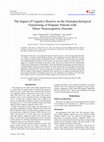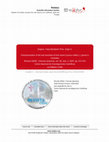Papers by Jorge Miguel Ariel Pino Pino

Food Science and Technology, 2012
Simultaneous Distillation-Extraction (SDE) and headspace-solid phase microextraction (HS-SPME) co... more Simultaneous Distillation-Extraction (SDE) and headspace-solid phase microextraction (HS-SPME) combined with GC-FID and GC-MS were used to analyze volatile compounds from plum (Prunus domestica L. cv. Horvin) and to estimate the most odor-active compounds by application of the Odor Activity Values (OAV). The analyses led to the identification of 148 components, including 58 esters, 23 terpenoids, 14 aldehydes, 11 alcohols, 10 ketones, 9 alkanes, 7 acids, 4 lactones, 3 phenols, and other 9 compounds of different structures. According to the results of SDE-GC-MS, SPME-GC-MS and OAV, ethyl 2-methylbutanoate, hexyl acetate, (E)-2-nonenal, ethyl butanoate, (E)-2-decenal, ethyl hexanoate, nonanal, decanal, (E)-β-ionone, Γ-dodecalactone, (Z)-3-hexenyl acetate, pentyl acetate, linalool, Γ-decalactone, butyl acetate, limonene, propyl acetate, Δ-decalactone, diethyl sulfide, (E)-2-hexenyl acetate, ethyl heptanoate, (Z)-3-hexenol, (Z)-3-hexenyl hexanoate, eugenol, (E)-2-hexenal, ethyl pentanoa...

Psychology, 2013
The purpose of this paper is to present the conceptual foundations used in the development of a c... more The purpose of this paper is to present the conceptual foundations used in the development of a cognitive health program for Hispanic patients who report memory concerns or complaints to their primary care physicians. These models are drawn from the field of neuropsychology, both as a professional endeavor and as a scientific discipline. This program has been developed based on prevailing models of higher cerebral functions, addressing primarily attention, memory, and executive functions. The role of neuropsychologists as active participants in the improvement of the cognitive status of the patients referred to them is not only emphasized in this article as going much beyond the diagnostic process, but also having an active participation in the subsequent treatment process. The models of attention that have served as the bases for the MCCI COGNITIVE HEALTH PROGRAM are those developed by Allan F. Mirsky and Michael I. Posner, while the memory model used is authored by Alan Baddeley. The two models of executive functions that are employed in the development of this program are those of Russell Barkley and Elkonon Goldberg. This program was also very much anchored on the concept of cognitive reserve and the work of Yaakov Stern was incorporated into the models used for the development of the program. The program is implemented in two phases. Patients referred by their primary care physicians undergo a functional neuropsychological evaluation to determine the nature and extent of their memory impairments. The results obtained in these evaluations are interpreted using the models referred to above. A treatment plan is developed and the program is implemented through the use of computer assisted cognitive rehabilitation procedures. The advantages of using computer assisted procedures are discussed in this article.

Psychology, 2013
The purpose of this study was to explore the impact of cognitive reserve, on the neuropsychologic... more The purpose of this study was to explore the impact of cognitive reserve, on the neuropsychological status of a sample of otherwise healthy Hispanic patients, who complained of memory difficulties, and thus were suspected to present minor neurocognitive disorder. To this effect, 100 consecutive cases referred for neuropsychological evaluation by their primary care physicians comprised the initial sample. Two groups of 32 patients were formed on the basis of their scores in the Cognitive Reserve Questionnaire (CRQ) that was administered to all participants. The results obtained by both groups in an eclectic battery of neuropsychological instruments were compared. The results indicated that the CRQ High Score group had significantly better performance than the CRQ Low Score group in the tests administered, except those tapped into memory processes. This was interpreted, to be related to the fact that all of these patients fell into the category of mild cognitive impairment of the amnestic type, as neither group performed well in these specific instruments. The findings of this study were interpreted to lend support to the notion that better cognitive reserve was associated with better cognitive status in the later years of life.
Revista Cubana De Plantas Medicinales, Dec 1, 2010
The Journal of Essential Oil Research, Nov 1, 2007
ABSTRACT

Revista Cenic Ciencias Quimicas, 2007
Characterization of the leaf essential oil from laurel (Laurus nobilis L.) grown in Colombia RESU... more Characterization of the leaf essential oil from laurel (Laurus nobilis L.) grown in Colombia RESUMEN. El laurel (Laurus nobilis L.) es un árbol perenne que se cultiva en muchas regiones cálidas del mundo, particularmente, en los países del Mediterráneo. Las hojas secas y su aceite esencial obtenido por destilación poseen un aroma y sabor especial, que favorecen su uso en numerosos productos alimenticios. El aceite esencial fue obtenido a partir de 200 g de hojas mediante hidrodestilación por 3 h en un equipo Clevenger, los cuales rindieron un contenido del 0,2 %. La composición química del aceite de las hojas del laurel cultivado en Colombia fue estudiada por Cromatografía de Gases-Espectrometría de Masas usando una columna capilar de cuarzo del tipo HP-5MS. En total, se identificaron 112 compuestos volátiles que representan el 95 % de su composición química. De ellos, 47 se reportan por primera vez en el laurel. Es interesante señalar la presencia de numerosos ésteres aromáticos no reportados anteriormente. Los componentes mayoritarios fueron 1,8-cineol (22,0 %), linalol (16,4 %), acetato de α-terpinilo (11,1 %) y β-cariofileno (9,0 %). El aceite de la hoja de laurel cultivado en Colombia posee similitud con la composición de otros aceites de laurel y pudiera ser usado como sustituto de los productos importados.
The Journal of Essential Oil Research, Sep 1, 2009
The chemical composition of the leaf oil of Bursera graveolens (Kunth) Triana et Planch. was stud... more The chemical composition of the leaf oil of Bursera graveolens (Kunth) Triana et Planch. was studied by GC and GC/MS. Ninety-seven constituents were identified, which constituted more than 92% of the leaf oil composition. The most prominent compounds were limonene (30.7%), (E)-β-ocimene (20.8%) and β-elemene (11.3%). The composition of the leaf oil was characterized by its richness in monoterpene and
Actas De Las I Jornadas Internacionales Sobre Reservas Marinas Murcia 24 Al 26 De Marzo De 1999 2001 Isbn 84 491 0492 0 Pags 277 281, 2001
Gestión y administración de recursos naturales en parques nacionales. Plan Director de parques na... more Gestión y administración de recursos naturales en parques nacionales. Plan Director de parques nacionales. Criterios de gestión. Medidas de regulación.

Chemistry Biodiversity, Mar 1, 2011
AbstractDrimys granadensis L.f., a native plant from Colombia, has been included in the Vademecum... more AbstractDrimys granadensis L.f., a native plant from Colombia, has been included in the Vademecum de Plantas Medicinales de Colombia by the Instituto de Investigación de Recursos Biológicos Alexander von Humboldt, due to its widespread use in the folk medicine for the treatment of gastrointestinal ailments. The chemical composition of the essential oil of Drimys granadensis obtained by hydrodistillation of the leaves was analyzed by GC and GC/MS analyses. A total of 85 components were identified, with the major compounds germacrene D (1, 14.7%), sclarene (9.5%), α-cadinol (7.3%), longiborneol acetate (2, 6.3%), drimenol (4.2%), (Z)-β-ocimene (3, 4.2%), α-pinene (4, 3.2%), and β-elemene (5, 2.7%). The essential oil was also tested against eight bacteria using the KirbyBauer disk-diffusion method. Most of the Gram-positive bacteria tested were susceptible to the D. granadensis essential oil, while the Gram-negative bacteria tested were not.

Journal of Food Quality, May 31, 2008
The effect of osmotic dehydration (OD) on the volatile compounds of guava fruits was studied. Osm... more The effect of osmotic dehydration (OD) on the volatile compounds of guava fruits was studied. Osmotic treatments were carried out at atmospheric pressure, at continuous vacuum and by applying a vacuum pulse (5 min under vacuum and the remaining time at atmospheric pressure) at different temperatures (30, 40 and 50C) and times (1, 2 and 3 h). The volatile compounds of fresh and dehydrated samples were obtained by simultaneous distillationextraction, and were analyzed by gas chromatography/mass spectrometry. In general, OD caused changes in the concentration of volatiles, depending on the process conditions. The use of lower temperatures and shorter treatment times can diminish the loss of volatiles with respect to the fresh samples. The greatest damage to volatiles loss is produced at 50C for up to 2 h under both pulsed and continuous vacuum. The lowest total volatiles loss occurred at 30 and 40C for up to 3 h under pulsed vacuum or atmospheric pressure.
Http Dx Doi Org 10 1080 0972060x 2011 10643590, Mar 12, 2013
ABSTRACT
The Journal of Essential Oil Research, Nov 1, 2010
Natural Product Communications, Jul 1, 2010
J Essent Oil Res, 2010
The volatile constituents from the sea grass Thalassia testudinum was analyzed by GC and GC/MS. O... more The volatile constituents from the sea grass Thalassia testudinum was analyzed by GC and GC/MS. One-hundred-forty-two constituents were identified which constituted more than 95% of the oil composition, all of them reported for the first time in this species. The most prominent volatile compound was ethyl (Z)-1-propenyl disulfide (31% of the total composition).

Uploads
Papers by Jorge Miguel Ariel Pino Pino